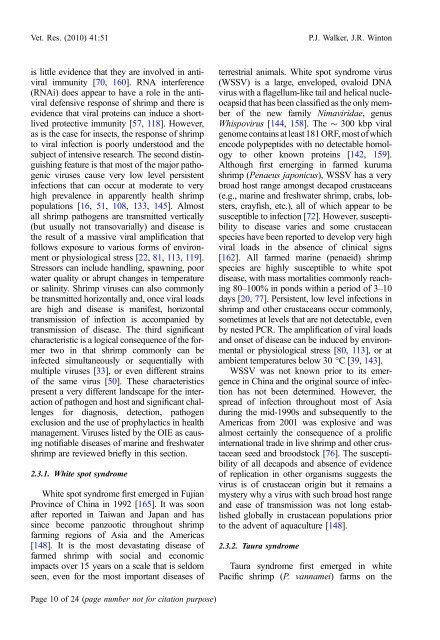Emerging viral diseases of fish and shrimp - Watershed Watch ...
Emerging viral diseases of fish and shrimp - Watershed Watch ...
Emerging viral diseases of fish and shrimp - Watershed Watch ...
Create successful ePaper yourself
Turn your PDF publications into a flip-book with our unique Google optimized e-Paper software.
Vet. Res. (2010) 41:51<br />
P.J. Walker, J.R. Winton<br />
is little evidence that they are involved in anti<strong>viral</strong><br />
immunity [70, 160]. RNA interference<br />
(RNAi) does appear to have a role in the anti<strong>viral</strong><br />
defensive response <strong>of</strong> <strong>shrimp</strong> <strong>and</strong> there is<br />
evidence that <strong>viral</strong> proteins can induce a shortlived<br />
protective immunity [57, 118]. However,<br />
as is the case for insects, the response <strong>of</strong> <strong>shrimp</strong><br />
to <strong>viral</strong> infection is poorly understood <strong>and</strong> the<br />
subject <strong>of</strong> intensive research. The second distinguishing<br />
feature is that most <strong>of</strong> the major pathogenic<br />
viruses cause very low level persistent<br />
infections that can occur at moderate to very<br />
high prevalence in apparently health <strong>shrimp</strong><br />
populations [16, 51, 108, 133, 145]. Almost<br />
all <strong>shrimp</strong> pathogens are transmitted vertically<br />
(but usually not transovarially) <strong>and</strong> disease is<br />
the result <strong>of</strong> a massive <strong>viral</strong> amplification that<br />
follows exposure to various forms <strong>of</strong> environment<br />
or physiological stress [22, 81, 113, 119].<br />
Stressors can include h<strong>and</strong>ling, spawning, poor<br />
water quality or abrupt changes in temperature<br />
or salinity. Shrimp viruses can also commonly<br />
be transmitted horizontally <strong>and</strong>, once <strong>viral</strong> loads<br />
are high <strong>and</strong> disease is manifest, horizontal<br />
transmission <strong>of</strong> infection is accompanied by<br />
transmission <strong>of</strong> disease. The third significant<br />
characteristic is a logical consequence <strong>of</strong> the former<br />
two in that <strong>shrimp</strong> commonly can be<br />
infected simultaneously or sequentially with<br />
multiple viruses [33], or even different strains<br />
<strong>of</strong> the same virus [50]. These characteristics<br />
present a very different l<strong>and</strong>scape for the interaction<br />
<strong>of</strong> pathogen <strong>and</strong> host <strong>and</strong> significant challenges<br />
for diagnosis, detection, pathogen<br />
exclusion <strong>and</strong> the use <strong>of</strong> prophylactics in health<br />
management. Viruses listed by the OIE as causing<br />
notifiable <strong>diseases</strong> <strong>of</strong> marine <strong>and</strong> freshwater<br />
<strong>shrimp</strong> are reviewed briefly in this section.<br />
2.3.1. White spot syndrome<br />
White spot syndrome first emerged in Fujian<br />
Province <strong>of</strong> China in 1992 [165]. It was soon<br />
after reported in Taiwan <strong>and</strong> Japan <strong>and</strong> has<br />
since become panzootic throughout <strong>shrimp</strong><br />
farming regions <strong>of</strong> Asia <strong>and</strong> the Americas<br />
[148]. It is the most devastating disease <strong>of</strong><br />
farmed <strong>shrimp</strong> with social <strong>and</strong> economic<br />
impacts over 15 years on a scale that is seldom<br />
seen, even for the most important <strong>diseases</strong> <strong>of</strong><br />
terrestrial animals. White spot syndrome virus<br />
(WSSV) is a large, enveloped, ovaloid DNA<br />
virus with a flagellum-like tail <strong>and</strong> helical nucleocapsid<br />
that has been classified as the only member<br />
<strong>of</strong> the new family Nimaviridae, genus<br />
Whispovirus [144, 158]. The 300 kbp <strong>viral</strong><br />
genome contains at least 181 ORF, most <strong>of</strong> which<br />
encode polypeptides with no detectable homology<br />
to other known proteins [142, 159].<br />
Although first emerging in farmed kuruma<br />
<strong>shrimp</strong> (Penaeus japonicus), WSSV has a very<br />
broad host range amongst decapod crustaceans<br />
(e.g., marine <strong>and</strong> freshwater <strong>shrimp</strong>, crabs, lobsters,<br />
cray<strong>fish</strong>, etc.), all <strong>of</strong> which appear to be<br />
susceptible to infection [72]. However, susceptibility<br />
to disease varies <strong>and</strong> some crustacean<br />
species have been reported to develop very high<br />
<strong>viral</strong> loads in the absence <strong>of</strong> clinical signs<br />
[162]. All farmed marine (penaeid) <strong>shrimp</strong><br />
species are highly susceptible to white spot<br />
disease, with mass mortalities commonly reaching<br />
80–100% in ponds within a period <strong>of</strong> 3–10<br />
days [20, 77]. Persistent, low level infections in<br />
<strong>shrimp</strong> <strong>and</strong> other crustaceans occur commonly,<br />
sometimes at levels that are not detectable, even<br />
by nested PCR. The amplification <strong>of</strong> <strong>viral</strong> loads<br />
<strong>and</strong> onset <strong>of</strong> disease can be induced by environmental<br />
or physiological stress [80, 113], or at<br />
ambient temperatures below 30 °C[39, 143].<br />
WSSV was not known prior to its emergence<br />
in China <strong>and</strong> the original source <strong>of</strong> infection<br />
has not been determined. However, the<br />
spread <strong>of</strong> infection throughout most <strong>of</strong> Asia<br />
during the mid-1990s <strong>and</strong> subsequently to the<br />
Americas from 2001 was explosive <strong>and</strong> was<br />
almost certainly the consequence <strong>of</strong> a prolific<br />
international trade in live <strong>shrimp</strong> <strong>and</strong> other crustacean<br />
seed <strong>and</strong> broodstock [76]. The susceptibility<br />
<strong>of</strong> all decapods <strong>and</strong> absence <strong>of</strong> evidence<br />
<strong>of</strong> replication in other organisms suggests the<br />
virus is <strong>of</strong> crustacean origin but it remains a<br />
mystery why a virus with such broad host range<br />
<strong>and</strong> ease <strong>of</strong> transmission was not long established<br />
globally in crustacean populations prior<br />
to the advent <strong>of</strong> aquaculture [148].<br />
2.3.2. Taura syndrome<br />
Taura syndrome first emerged in white<br />
Pacific <strong>shrimp</strong> (P. vannamei) farms on the<br />
Page 10 <strong>of</strong> 24 (page number not for citation purpose)
















